

Five Myths About North Korea, by Joel S. Wit & Jenny Town. [This article appeared in the 29 March 2013 edition of The Atlantic Monthly.

Joel S. Wit is a visiting fellow with the U.S. -Korea Institute at Johns Hopkins School of Advanced International Studies and founder of its North Korea website, 38North. Jenny Town is a research associate at the Institute and the editor of its website. --CanKor] Yes, we should be taking Kim Jong Un’s recent threats seriously. (Photo by Erich Weingartner) Every day the media is filled with reports of North Korea threatening to attack the United States and its close allies. Americans should be deeply concerned about these events. Pit or Get Off the Shot: Is North Korean Going to Flight Test the Musudan or Not?
By Jeffrey Lewis16 May 2013 So, are the North Koreans going to test a fricking Musudan or what?
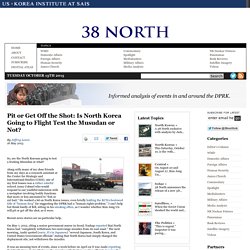
Along with many of my close friends from my days as a research assistant at the Center for Strategic and International Studies (CSIS), one of my first bosses was a rather colorful retired Army Colonel who would respond to our youthful indecision with a metaphor involving bodily functions that more or less amounted to “fish or cut bait.” He worked a lot on North Korea issues, even briefly holding the KCNA-bestowed title of “human dreg” for suggesting the DPRK had a “human rights problem.” I can’t help but think fondly of Bill, sitting in his smoking office, as I wonder whether Kim Jong Un will pit or get off the shot, as it were.
Recent news stories are no particular help. On May 7, 2013, citing a senior government source in Seoul, Yonhap reported that North Korea had “completely withdrawn two mid-range missiles from its east coast.”
There's No North Korea Crisis. From the hysterical TV portrayals of goose-stepping North Korean troops, breathless news reports of North Korean warnings of war, and maps depicting the range of imminent missile launches (complete with retired U.S. generals explaining the targets), you might think there is a crisis on the Korean Peninsula.
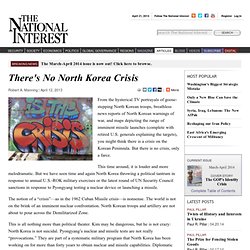
But there is no crisis, only a farce. This time around, it is louder and more melodramatic. North Korea: What’s really happening. We all know it’s a crisis.
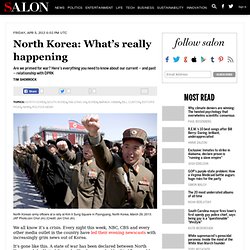
Every night this week, NBC, CBS and every other media outlet in the country have led their evening newscasts with increasingly grim news out of Korea. It’s gone like this. A state of war has been declared between North Korea and the United States by Kim Jong-un, the North’s 27-year-old hereditary dictator. North Korea has battle plans to attack Washington and other U.S. cities, including, of all places, Austin, Texas, with atomic weapons. The Kaesong Industrial Zone, the last demonstration of North and South Korean cooperation just above the DMZ, has been temporarily shut down after the North refused entry to South Koreans who work there. The sense of hysteria and impending doom has been magnified by the Obama administration and the Pentagon. The rhetoric has ratcheted up too – to alarming levels. And then, out of the blue, President Obama and his military leaders came out on Thursday and sought to calm the waters – and the skies. U.S. Wargames North Korean Regime Collapse, Invasion to Secure Nukes.
<br/><a href=" US News</a> | <a href=" Business News</a> Copy North Korea's young leader Kim Jong Un today ordered his missile batteries to prepare to launch against U.S. and South Korea targets, the latest act of belligerence that has left the United States and the world on edge in recent weeks.
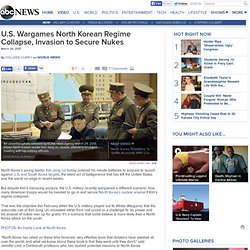
But despite Kim's menacing posture, the U.S. military recently wargamed a different scenario: how many American troops would be needed to go in and secure North Korea's nuclear arsenal if Kim's regime collapsed. That was the objective this February when the U.S. military played out its Winter Wargame, that the autocratic rule of Kim Jong Un unraveled either from civil unrest or a challenge to his power and his arsenal of nukes was up for grabs. Tactically Smart, Strategically Stupid: Simulated B52 Nuclear Bombings in Korea.
Recommended Citation Peter Hayes, "Tactically Smart, Strategically Stupid: Simulated B52 Nuclear Bombings in Korea", NAPSNet Policy Forum, March 21, 2013, by Peter Hayes 20 March 2013 Click here to go to the PDF version of this report Nautilus invites your contributions to this forum, including any responses to this report.
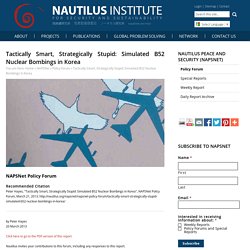
Introduction Peter Hayes states, “Deploying nuclear capable bombers accompanied by nuclear threat rhetoric will not quell regressive proliferation sentiment in Seoul. Think Again: North Korea - By David Kang and Victor Cha. "North Korea's not that dangerous.

" Wrong. There is no threat of war on the Korean peninsula because the United States and South Korea have deterred the regime for over six decades, or so the thinking goes. And the occasional provocation from Pyongyang -- full of sound and fury -- usually ends with it blowing up in its face, signifying nothing. Four reasons not to take North Korea’s threats of nuclear war too seriously.
Today North Korea declared itself in a “state of war” with South Korea. Rockets are reportedly on standby to “mercilessly strike” the United States. Pyongyang has progressively cut off various military hotlines that connect it to the US and Seoul, threatened to close the Kaesong industrial complex staffed by workers from both Koreas, and torn up the armistice agreement that ended war between them in 1953.
Tension has been high since February when North Korea completed a third nuclear test. But here are some reasons not to worry—at least not yet. 1. Threatening crisis is how North Korea wins concessions from its neighbor to the south and other powers. This time, Pyongyang’s more aggressive stance belies vulnerability, Snyder says. Understanding North Korea. By Published by the Foreign Policy Research Institute By Kongdan Oh When the third son of dying leader Kim Jong-il was designated as the successor of his ailing father in December 2011, the media asked me to comment on the young (28 or 29) Kim’s inclination to reform North Korea’s politics and economy.
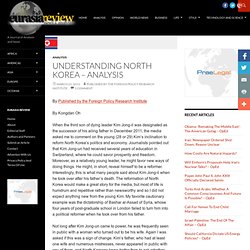
Anaylsis: N Korea rhetoric against US, S Korea. North Korea: Preparing for War. The latest in the North Korea drama is the release of a video portraying US President Barack Obama and American troops going up in flames.

But it’s not just cheap and cheesy rhetoric by a new leader who wants to be taken seriously: North Korea is preparing for a war because the US has been preparing for an offensive. Earlier this month, we were regaled with a similar video, this time portraying a US city being attacked by North Korean missiles. Before that, in December, North Korea launched a satellite, and its official news agency declared a “Nationwide preparation for an all-out great war for national reunification.” North Korea and the United States: Will the Real Aggressor Please Stand Down? Troops land at P'ohang-Dong, Korea during the Korean war.
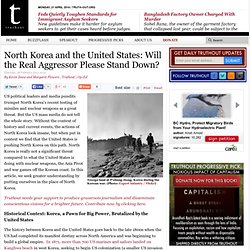
(Photo: Expert Infantry / Flickr)US political leaders and media pundits trumpet North Korea's recent testing of missiles and nuclear weapons as a great threat. But the US mass media do not tell the whole story. The North Korea Problem. Pyongyang has successfully tested a long-range rocket. What may happen next — including missiles someday armed with nuclear warheads — could make matters worse. After announcing that its rocket was facing technical difficulties that might delay its impending test, North Korea surprised the international community by abruptly launching a three-stage rocket on Wednesday morning local time. Even more surprising than the timing was that the “Unha” (the Korean word for “galaxy”) rocket appears to have successfully placed the Kwangmyongsong-3 (“Shining Star-3”) satellite into orbit, albeit there are reports that it is encountering difficulties.
But space enthusiasts have nothing to cheer. Under the guise of developing a space launch vehicle, the Democratic People’s Republic of Korea (DPRK) is pursuing an intercontinental-range missile (ICBM) capability that would allow it reach targets as far away as California and Alaska.